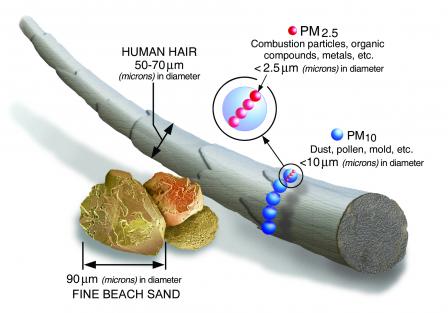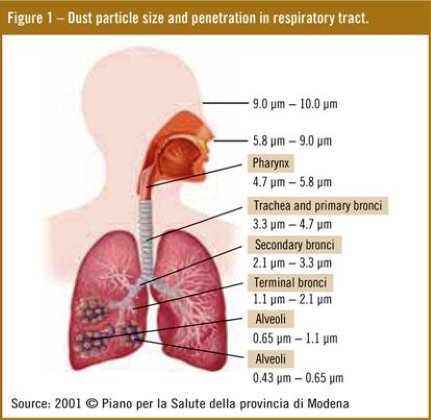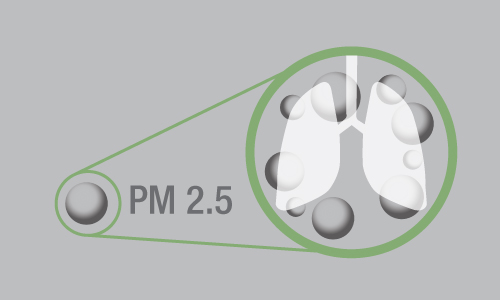What can be said about particulate matter? It’s everywhere. Whether it’s larger, visible particles like dust, soot, or road dirt, or smaller particles that are visible en masse like smoke or smog; these particles can cause a lot of issues ranging from temporary discomfort to chronic health issues, as well as reduce visibility and combine with other chemicals to cause compounded damage.
Following our investigations into Volatile Organic Compounds (VOCs), our deep-dive into their prevalence and removal strategies for VOCs in paint manufacturing, and our look at Hazardous Air Pollutants (HAPs), we would like to look at another ‘enemy’ of sorts, particulate matter/particle pollution, most commonly referred to as PM2.5 and PM10 based on the size of the particulate matter in question.
Understanding Particulate Matter
 In manufacturing, construction, and a multitude of other industries, there are a lot of emissions. While some of the dangerous emissions are at the molecular (Arsenic, Beryllium) or compound level (Arsenite, Benzene), particulate matter is more complex, larger, and is defined as a mixture of solid particles and liquid droplets in the air.
In manufacturing, construction, and a multitude of other industries, there are a lot of emissions. While some of the dangerous emissions are at the molecular (Arsenic, Beryllium) or compound level (Arsenite, Benzene), particulate matter is more complex, larger, and is defined as a mixture of solid particles and liquid droplets in the air.
This isn’t to say they are large—particulate matter is at least 5 times smaller than the width of a human hair, as displayed in the image to the right.
Definitions of Particulate Matter
While explaining PM on their site, the United States Environmental Protection Agency (EPA) defines PM as “the term for a mixture of solid particles and liquid droplets found in the air. Some particles, such as dust, dirt, soot, or smoke, are large or dark enough to be seen with the naked eye. Others are so small they can only be detected using an electron microscope.”
It is convenient to classify particles by their aerodynamic properties because:
(a) these properties govern the transport and removal of particles from the air; (b) they also govern their deposition within the respiratory system and (c) they are associated with the chemical composition and sources of particles. These properties are conveniently summarized by the aerodynamic diameter, that is the size of a unit-density sphere with the same aerodynamic characteristics. Particles are sampled and described on the basis of their aerodynamic diameter, usually called simply the particle size.
PM10 and PM2.5: Different Behaviors, Different Impacts
Broken down into PM2.5 and PM10, the different sized particles behave very differently in the atmosphere. It is convenient to classify particles by their aerodynamic properties because:
- these properties govern the transport and removal of particles from the air;
- they also govern their deposition within the respiratory system and
- they are associated with the chemical composition and sources of particles.
These properties are conveniently summarized by the aerodynamic diameter, that is the size of a unit-density sphere with the same aerodynamic characteristics. The following image, found on the website All About Feed, shares just how far each particle can travel into your body, lungs, and even bloodstream.

PM10: Particulate Matter 10 Microns or Less (Coarse Particles)
PM10 is particulate matter that is between 2.5 micrometers and 10 micrometers in diameter. Often less impactful in Air Quality Index (AQI) measures, these particles are often more localized due to their size, and do not travel as far.
Generally visible to the human eye, PM10 particles are usually the result of crushing or grinding operations (concrete grinding, countertop building), dust or dirt particles small enough to get kicked up into the air, pollen, or mold. Often, PM10 is inhalable, causing reactions such as coughing and irritation, but not respirable, in which particulate matter reaches the gas-exchange zone deep in the human lungs. Particles smaller than 5 microns are respirable, and cause serious damage to the respiratory system.
PM2.5: Particulate Matter 2.5 Microns or Less (Fine Particles)
Technically a subset of PM10 (all things smaller than 2.5 microns are smaller than 10 microns), PM2.5 includes anything smaller than 2.5 microns in diameter. Fine particles are produced from all types of combustion—from a wood-burning stove to industrial applications—as well as secondarily-formed aerosols and organic and metal vapors.
These are known to travel farther, impair visibility, cause more damage when inhaled, and react with other chemicals to cause even more problems in the form of secondary PM. For more information on the National Ambient Air Quality Standards limits, measurements, and trends for PM10 and PM2.5, please visit the EPA report on the environment.
Primary and Secondary Particulate Matter
Particulate matter, as with VOCs, is emitted as a result of both human and natural means. While primary PM is dangerous, secondary is the result of airborne chemical reactions, and can lead to many negative effects.
Primary/Direct
PM created by direct means is called primary, and can occur both naturally and from human activity. A wood stove (human) or wildfire (natural) produces smoke, which pushes PM into the air.
Secondary
Secondary PM can be much more dangerous, as chemicals or other contaminants released into the atmosphere react with other emissions—SOx, NOx, Volatile Organic Compounds, and ammonia in sunlight to produce compounded negative effects.
For example, sulphur dioxide is oxidized in the atmosphere to form sulphuric acid (H2SO4), which can be neutralized by NH3 to form ammonium sulfate. Nitrogen dioxide (NO2) is oxidized to nitric acid (HNO3), which in turn can react with ammonia (NH3) to form ammonium nitrate (NH4NO3).
Reducing the Impacts of Particulate Matter on Humans and the Environment
Particulate matter is a danger to population health, environmental enjoyment, and environmental use, per the EPA. Even with PM concentrations improving by more than 35% between 2000 and 2015, watchdogs, environmental groups, and regulators will be on the lookout, and are ready to name and shame any organization contributing to pollution, whether in the form of HAP, VOC, or PM emissions.
Reduce VOCs and HAPs, Reduce the Reactions Causing Secondary PM
One of the best ways to reduce the impact that PM can have on the environment is to reduce emissions of reactive components. A fair amount of the secondary PM that is created comes when vapors or particles react with Volatile Organic Compounds, something that you should already be working to reduce.
There are many ways to reduce the amount of VOCs and HAPs, in turn reducing the creation of secondary PM. The CMM Specializes in VOC and HAP abatement by building custom machines designed to remove many pollutants from your manufacturing processes. No matter the industry, we have been around to help organizations just like yours install an oxidizer that is efficient and effective.
If you’re ready to learn more about VOC Abatement Solutions, we welcome you to learn about the different procedures and different criteria for selecting a solution in our two part blog series, and download our complete checklist to buying an Air Pollution Control System here.




